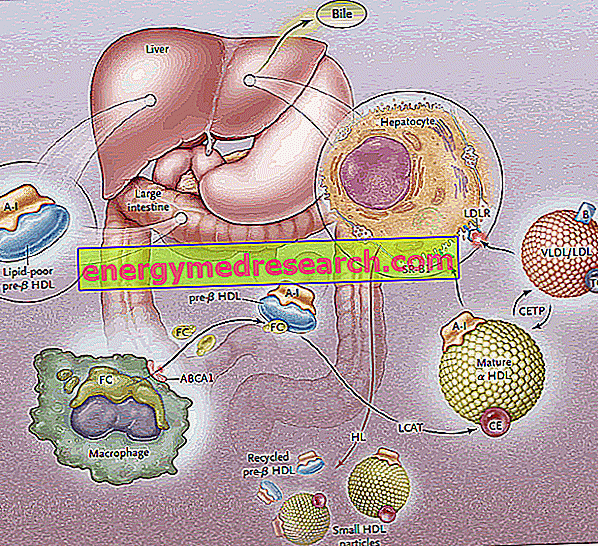Generality
The ozena is a form of chronic rhinitis characterized by the progressive atrophy of the nasal mucosa, which becomes thin and dysfunctional.
The pathological process typically involves the formation of crusts in the nasal cavities and the perception of a nauseating smell .

Over time, the pathological process leads to an abnormal patency of the nostrils and may also involve the periosteum (fibrous membrane that surrounds the bone), with atrophy of the nasal skeleton (especially that of the turbinates).
If ozone is not adequately treated, recurrent and severe manifestations can make the patient's social life difficult and predispose to depression.
The causes of ozone are not yet fully known, but some factors have been identified that could play a role in determining the onset of the disorder. The various hypotheses include the colonization by bacteria capable of damaging the mucosa and the predisposing anatomical conformation of the nasal cavities.
The ozone is diagnosed based on the combination of suggestive symptoms and clinical examination of the nasal cavities (rhinoscopy). Depending on the specific case, the symptoms can be managed with local antibiotic therapies, nasal washes and surgical correction procedures.
Causes and Classification
The ozena (or chronic atrophic rhinitis ) can be classified into two forms: primary (or idiopathic) and secondary . These clinical syndromes have distinct presentations and affect different patient populations.
Primary ozena
- Chronic primary atrophic rhinitis is observed mainly among young subjects living in geographical areas with warm climates, belonging to the lower socio-economic groups; high prevalence areas include Saudi Arabia, Africa, India and China, while the disease is rare in Europe and the United States of America. The low incidence in developed countries is probably related to the widespread availability of antibiotics.
- The factors that predispose some individuals to develop primary atrophic rhinitis are not yet completely known. At the basis of the disorder, several physiopathological mechanisms have been proposed. In particular, endocrine imbalances seem to be relevant (the primary ozone tends to present itself from puberty and more frequently involves the female sex), nutritional deficiencies (such as iron or vitamin A or D deficiency) and the intervention of agents infectious (including Klebsiella ozaenae, Escherichia coli, Staphylococcus aureus and Streptococcus pneumoniae ). The ozone could also depend on environmental exposure to some pollutants and genetic predisposition (in some cases, the disorder recurs within the same family). Furthermore, vascular, autoimmune, anatomic and metabolic factors may be involved in the etiology.
- The primary presenting symptom is a foul-smelling nasal discharge.
- From the histological point of view, the primary ozone is characterized by a marked metaplasia, with substitution of the epithelium from ciliato to multi-layered plate. This abnormal tissue is poor in cilia, muciparous cells and small, goblet-like acinar glands, which normally produce that thin layer of mucus that covers the entire surface of the nasal mucosa. In the submucosa, a chronic phlogosis is observed with a progressive infiltrate of inflammatory cells composed of lymphocytes and plasma cells, which leads to the formation of sclerotic connective tissue. This favors some abnormalities of the small blood vessels (ranging from neovascularization to obliterative arteritis) and the reabsorption of the skeleton of the nasal cavities (in particular, of the lower turbinates).
Secondary ozena
- Secondary atrophic rhinitis is found mainly in developed countries and occurs in patients who have undergone previous traumas or surgery, which result in mucosal damage and superinfection. Symptoms have also been seen in patients undergoing sinus radiotherapy or suffering from granulomatous diseases of the upper respiratory tract (such as leprosy, tuberculosis, sarcoidosis, Wegener's granulomatosis or syphilis).
- Subjects with ozena differ from those with chronic "traditional" rhinosinusitis due to the intractable nature of their symptoms and persistent mucopurulent secretions.
- The secondary ozone can be distinguished by two subtypes: a " wet " and a " dry " form.
- The typical patient with the wet form underwent more surgery on the paranasal sinuses (such as a radical turbinectomy) and, now, experiences chronic rhinosinusitis with purulent mucus production. The presence of E. coli, Pseudomonas aeruginosa and Staphylococcus aureus can be found in the secretion. Often, it is difficult to assess whether the symptoms are related to these infections or whether the bacteria represent the colonization of an already damaged epithelium with poor mucociliary function. Antibiotics do not resolve this condition or even make it worse.
- The dry form of secondary ozena, on the other hand, leads to dryness of the nasal mucosa with the formation of bloody crusts. This presentation may depend on the disappearance of the mucous and serous secretion of the glandular epithelium of the nose. The dry form is more commonly found in patients with sarcoidosis of the upper respiratory tract.
Signs and Symptoms
The ozone is a condition with a chronic course, characterized by a marked and widespread atrophy of the nasal mucosa .
Initially, this pathological process manifests itself with congestion (a sense of a stuffy nose), difficult breathing, epistaxis and secretions that form incessantly in the nasal cavities. The latter tend to accumulate in large yellowish-green crusting masses, which give off a typical stench, although the patient often does not realize it (both due to the adaptation to the smell, and to the atrophy of the olfactory mucosa).
Over time, the ozone also involves the turbinates and nerve endings that run into the nose. In some cases, the pathological process can be further spread, even affecting the mucosa of the pharynx and larynx.
Many patients also have concomitant sinusitis; in these cases, the disorder can be more accurately termed atrophic rhinosinusitis .
Primary ozena
Patients with primary atrophic rhinosinusitis manifest halitosis (evident to others) and the constant perception of a bad odor (cacosmia). The most common presentation symptoms include scab formation, purulent discharge and a feeling of nasal obstruction. The clinical examination of the nasal cavities reveals a shiny, thin, pale and dry mucosa, covered by thick yellow, brown or green crusts, which can be bloody or covered with pus.
Other manifestations of the primary ozone include: anosmia, epistaxis, nasal pain, sleep disturbances and choking aspiration.
Secondary ozena
Patients with secondary atrophic rhinosinusitis manifest nasal congestion, dryness and bloody crusting in the nasal passages. Instead, other people have mucopurulent, dense and viscous secretions.
Secondary ozone can commonly be associated with facial pain, recurrent epistaxis and episodic anosmia. Some patients also experience retronasal discharge, cacosmia and sinusitis episodes.
Possible complications
- In some forms of ozena, skeletal resorption of the nasal cavities can occur (in particular, at the level of the lower turbinates). This can cause bending of the lateral nasal wall or saddle deformity of the nose. Sometimes, perforation of the nasal septum can also occur.
- The progressive atrophy of the nasal mucosa can be complicated by infections .
- Severe and persistent symptoms of ozone can induce social isolation and depression .
Diagnosis
The diagnosis of ozone (primary or secondary) is formulated on the basis of suggestive symptoms, rhinoscopy and imaging techniques, such as radiographic investigations or computed tomography (CT).
Rhinoscopy reveals a thin erythematous mucosa, with nasal secretions and crusting. The nasal cavities can be enlarged, particularly in the primary form.
Computed tomography (CT) of the nose and paranasal sinuses can reveal a combination of mucosal atrophy and bone resorption, with widening of the nasal cavities and destruction of the lateral wall.
In cases where a basic and causal disease is suspected, other diagnostic tests must be performed.
Treatment
- Ozena rarely regresses spontaneously; moreover, a real healing is never obtained, as the mucosal atrophy remains an irreversible phenomenon.
- The ozone therapy is directed to the reduction of scabs and the elimination of the bad smell by mechanical removal of secretions (diluting them with suitable warm pads or washes) and the administration of topical antibiotics . If necessary, any hormonal imbalances, metabolic defects and related vitamin deficiencies are corrected.
- Instead, in the presence of secondary atrophic rhinitis, therapy should focus on the underlying disease.
- For patients with ozena, the doctor may indicate performing nasal washes with heated saline solution, at least twice a day; after this operation, the application of lubricants may be useful to avoid dryness of the nasal mucosa. In the presence of a purulent nasal discharge, it may be advised to add an antibiotic to the washing solution until the disappearance of this manifestation. Thermal inhalation treatments with sulphurous waters are also useful.
- Systemic antibiotic therapy is indicated, however, for acute bacterial sinus infections (eg quinolones) associated with ozone.
- The surgical correction of the excessive width of the nasal cavities can be useful to restore good ventilation and reduce the formation of crusts caused by the drying effect of the air flow on the atrophic mucosa.



